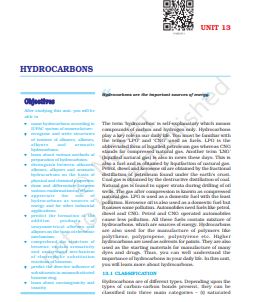
Hydrocarbons
13.1 Classification
Hydrocarbons are of different types. Depending upon the types of carbon-carbon bonds present, they can be classified into three main categories – (i) saturated (ii) unsaturated, and (iii) aromatic hydrocarbons.
Saturated hydrocarbons contain carbon-carbon and carbon-hydrogen single bonds.
If different carbon atoms are joined together to form an open chain of carbon atoms with single bonds, they are termed alkanes as you have already studied in Unit 12.
On the other hand, if carbon atoms form a closed chain or a ring, they are termed as cycloalkanes. Unsaturated hydrocarbons contain carbon-carbon multiple bonds – double bonds, triple bonds, or both.
Aromatic hydrocarbons are a special type of cyclic compounds.
You can construct a large number of models of such molecules of both types (open chain and close chain) keeping in mind that carbon is tetravalent and hydrogen is monovalent.
For making models of alkanes, you can use toothpicks for bonds and plasticine balls for atoms. For alkenes, alkynes, and aromatic hydrocarbons, spring models can be constructed.
13.2 Alkanes
As already mentioned, alkanes are saturated open chain hydrocarbons containing carbon-carbon single bonds. Methane (CH4) is the first member of this family.
Methane is a gas found in coal mines and marshy places. If you replace one hydrogen atom of methane by carbon and join the required number of hydrogens to satisfy the tetravalence of the other carbon atom, what do you get? You get C2H6.
This hydrocarbon with molecular formula C2H6 is known as ethane. Thus you can consider C2H6 as derived from CH4 by replacing one hydrogen atom by -CH3 group. Go on constructing alkanes by doing this theoretical exercise
13.2.1 Nomenclature and Isomerism
You have already read about the nomenclature of different classes of organic compounds in Unit 12. Nomenclature and isomerism in alkanes can further be understood with the help of a few more examples.
Common names are given in parenthesis. The first three alkanes – methane, ethane, and propane have only one structure but higher alkanes can have more than one structure.
Let us write structures for C4H10. Four carbon atoms of C4H10 can be joined either in a continuous chain or with a branched-chain in the following two ways :
| Author | – |
| Language | English |
| No. of Pages | 33 |
| PDF Size | 4.7 MB |
| Category | Chemistry |
| Source/Credits | – |
Hydrocarbons PDF Free Download
